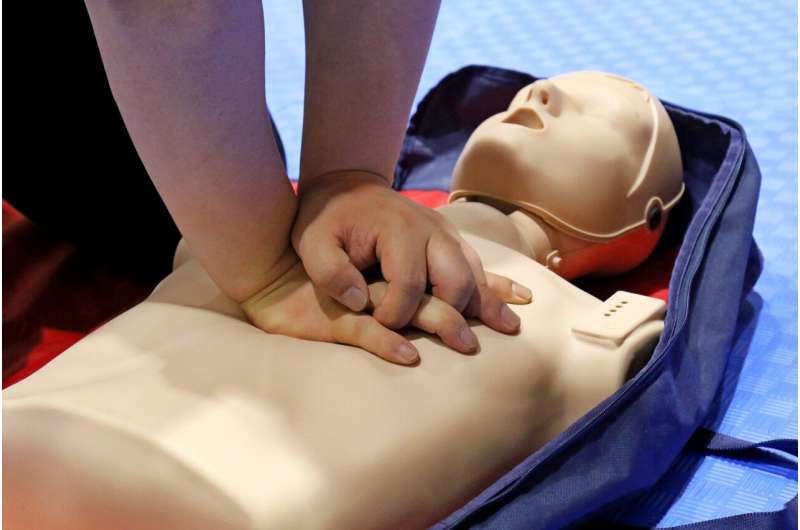This article has been reviewed according to Science X's editorial process and policies. Editors have highlighted the following attributes while ensuring the content's credibility:
fact-checked
trusted source
proofread
CPR willingness grows in the US, but the need to act remains

More Americans than ever now say they are willing to perform cardiopulmonary resuscitation (CPR) in the event of an emergency, according to newly released survey data from the American Heart Association. Thanks in part to the recent efforts of the Association and others, the percentage of surveyed adults in the U.S. who say they now feel they have the confidence to perform CPR has increased from 30% to 35%. But scientific data still indicates that fewer than half of all people experiencing cardiac arrest outside of a hospital receive CPR before emergency services arrive.
"There are certain medical emergencies where a moment cannot be wasted and sudden cardiac arrest is one of them," said Nancy Brown, chief executive officer of the American Heart Association. "At the American Heart Association, we've moved the needle towards willingness to perform CPR over the past two years—and that is powerful. But there is so much more to do; we have a goal of doubling survival from cardiac arrest by building a nation of lifesavers who are confident and able to act when the time comes."
To improve the chances of everyone, everywhere surviving a cardiac arrest, the Association launched its Nation of Lifesavers movement a year ago during National CPR and AED Awareness Week (June 1–7). This year, which marks a century of lifesaving service for the American Heart Association, the organization is offering education and activities that can turn a nation of bystanders into a nation of lifesavers, including a new Hands-Only CPR virtual reality (VR) experience, housed within the Meta Oculus app store and a new public service announcement inspiring bystanders to become lifesavers by learning CPR and being prepared to respond in a medical emergency.
CPR is a key link in the chain of survival for many medical emergencies and is especially important as we head into the summer months. Extreme heat may increase incidents of cardiac arrest and an average of 33 drownings occur in the U.S. each day, one-third of which are fatal. Drowning is the second-leading cause of death in children between ages 1 and 4. Conventional CPR, also known as CPR with breaths, should be performed on children and infants, and in certain cases such as drowning and overdose. Unfortunately, only 39% of those surveyed are familiar with conventional CPR and only 23% with Hands-Only CPR.
The American Heart Association offers multiple ways to learn CPR and join the Nation of Lifesavers, as an individual, family, organization or community.
- Watch online. Learn the basics of Hands-Only CPR with this instructional video and share it on social media with #NationofLifesavers. Hands-Only CPR has just two simple steps, performed in this order: 1) Call 911 if you see a teen or adult suddenly collapse; and 2) Push hard and fast in the center of the chest to the beat of a familiar song that has 100 to 120 beats per minute like "Stayin' Alive" by the BeeGees, "The Man" by Taylor Swift or "Jolene"—with both Dolly Parton and Beyonce's versions being the correct beats per minute. More songs can be found on the Association's playlist.
- Immerse yourself. Through the Association's new VR app, learn how to perform Hands-Only CPR and use an AED, then put your skills to the test in three real-life scenarios.
- Learn at home. Learn basic lifesaving skills in about 20 minutes from the comfort and privacy of home with the CPR Anytime kits. The Infant CPR Anytime program is for new parents, grandparents, babysitters, nannies and anyone who wants to learn lifesaving infant CPR and choking relief skills. The Adult & Child CPR Anytime Training kit teaches adult/teen Hands-Only CPR, child CPR with breaths, adult and child choking relief and general awareness of automated external defibrillators—or AEDs. CPR Anytime now includes the Adult & Child CPR Anytime Interactive app to provide a comprehensive, self-facilitated training solution in one web-based app that allows students to elevate their CPR and AED training experience through gamification.
- Take a course. Find a class nearby to learn the lifesaving skills of CPR, first aid and AED use. Encourage others by sharing on social media with #NationofLifesavers.
- Turn employees and coworkers into lifesavers. Help make your workplace and community safer one step at a time by forming a Heart Walk team and committing to CPR training for your employees.
- Become an advocate. Join You're the Cure, the American Heart Association grassroots network and show your support for public policies that can save lives from cardiac arrest. Together with the Smart Heart Sports Coalition, the Association is working to pass laws in all 50 states that will ensure schools, school athletic facilities and school events have a cardiac emergency response plan and require training in CPR and AED for school athletic coaches.
In 2009, the American Heart Association launched a nationwide Hands-Only CPR campaign to raise awareness about this life-saving skill. Since 2012, 11 million people have learned Hands-Only CPR from the American Heart Association via events, training kiosks and video education with the support of Elevance Health Foundation.




















